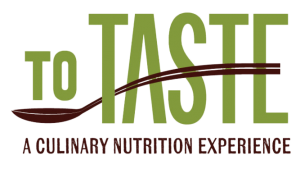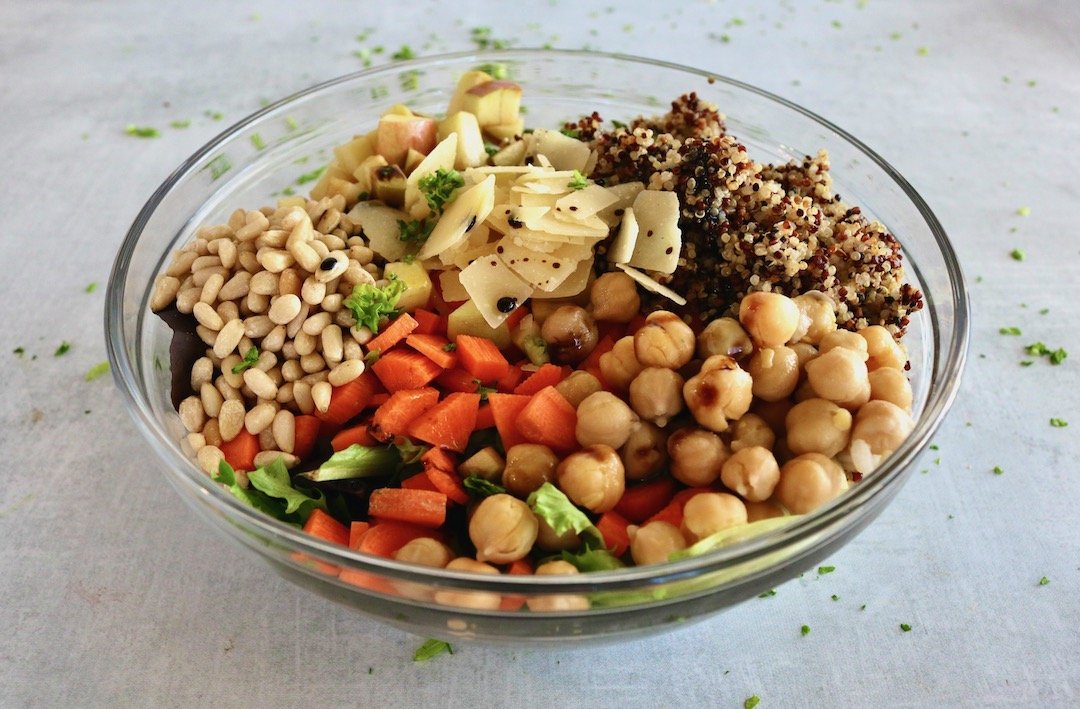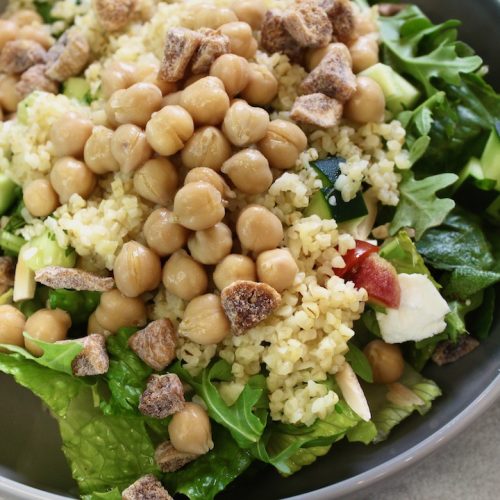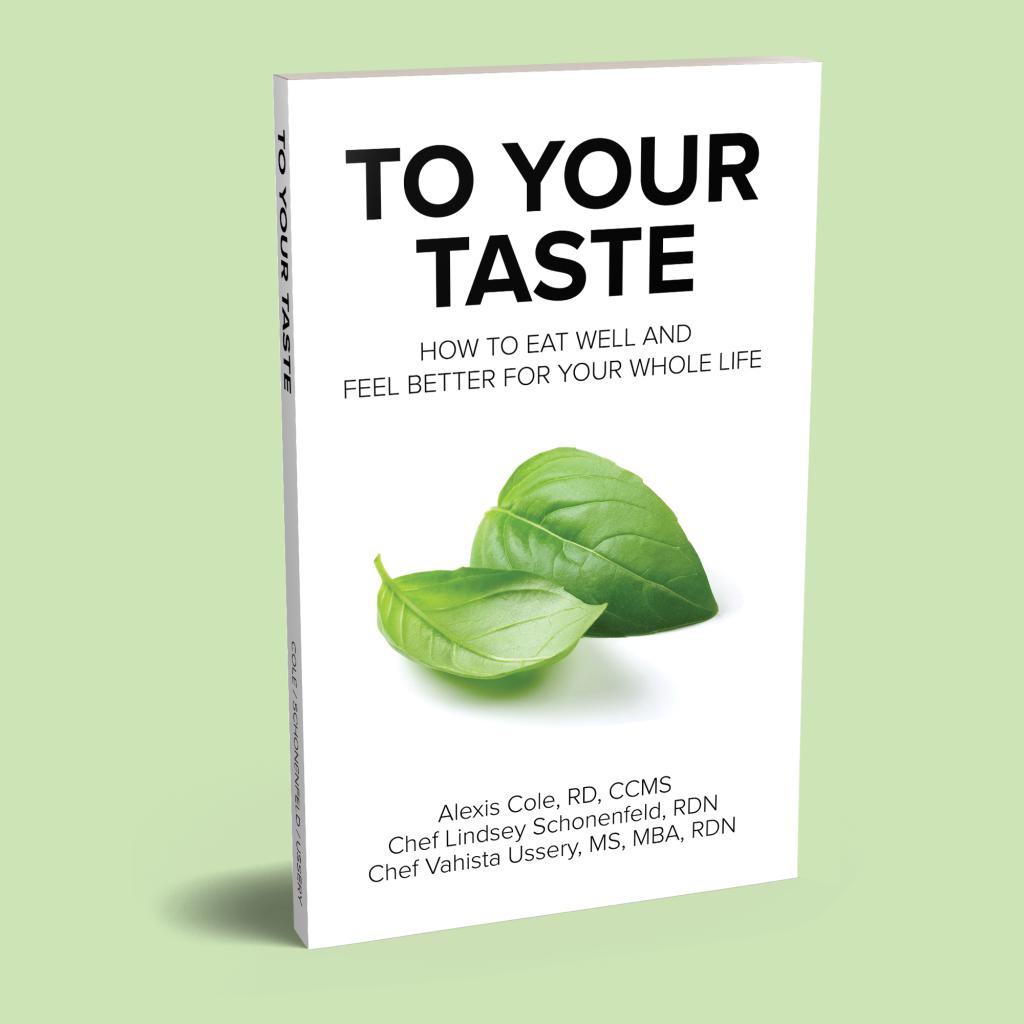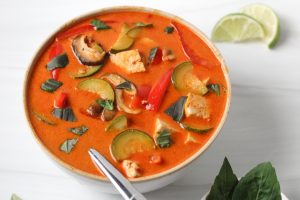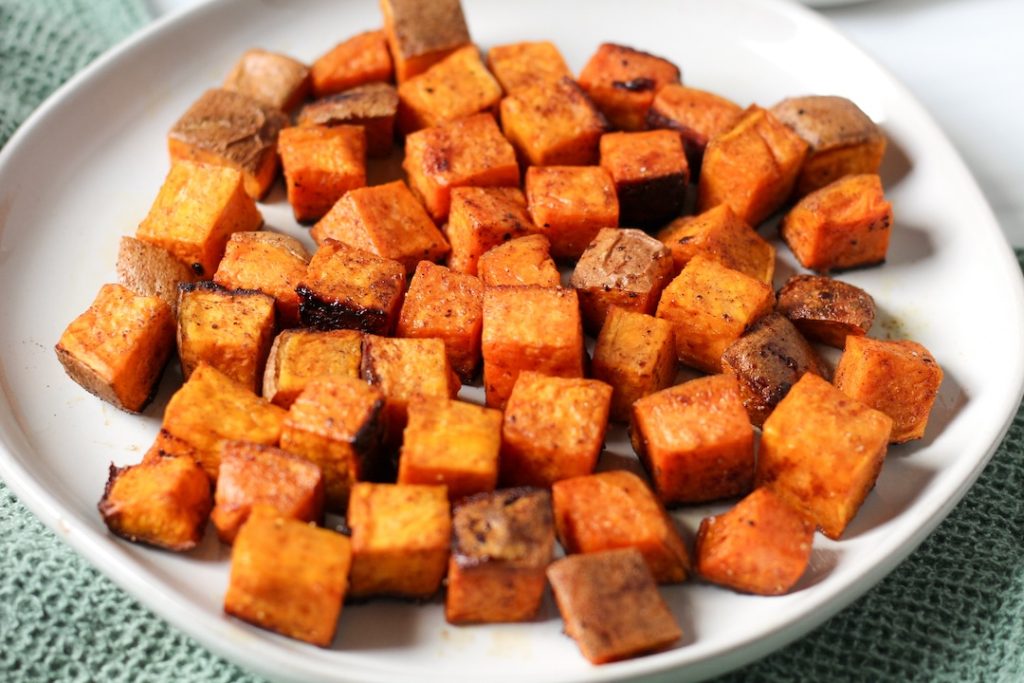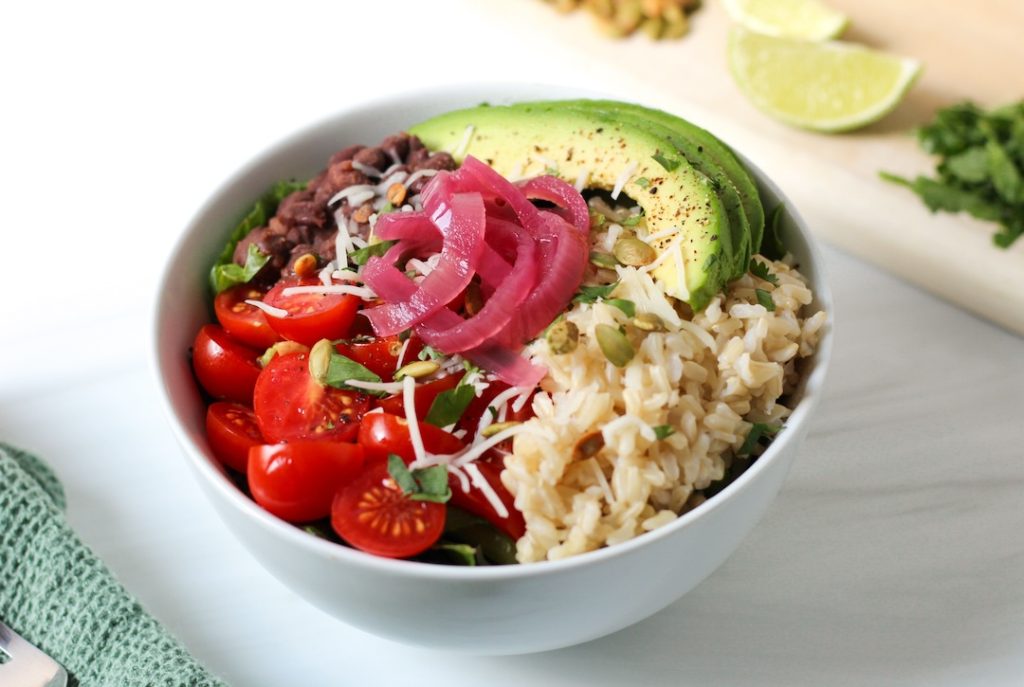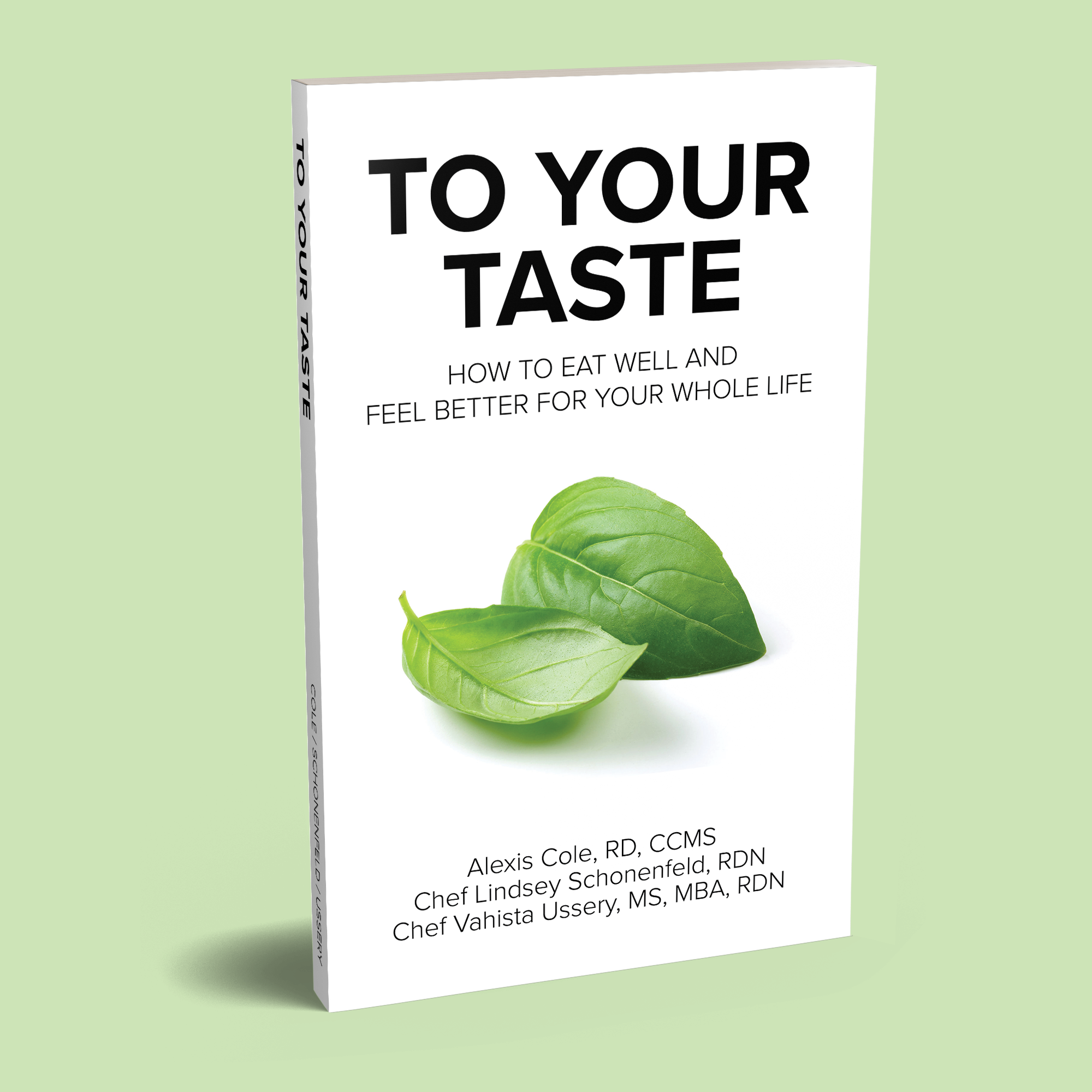This is the variation of our green salad base recipe featured in our Whole Life Meal Plan. Just say NO to sad salads! The best salads include a variety of ingredients from multiple food groups that provide different textures. Every bite of this chickpea green salad is delicious, creamy, and crunchy!
Learn How to Make the Base Recipe
Three Must Know Cooking Skills
For recipe success, learn how to:
Culinary Tips for the Best Chickpea Green Salad Recipe
Consider cooking the bulgur in advance, and preparing more than called for in the recipe. It makes a great addition to a grain salad or a simple side at dinner later in the week. You can add the bulgur warm, cold, or at room temperature – it’s up to you!
Drying the greens after washing ensures a crisp salad and increases shelf life of the greens that you don’t use in today’s salad. Consider purchasing a salad spinner to complete this task if you don’t already have one.
For better texture, chop or shred the leafy greens. No one likes choking on spinach stems! You can chop the greens before adding to the salad bowl, or simply shred them with a fork and knife after you’ve added everything else. Dicing or slicing all of your ingredients into bite-sized pieces makes for easier eating.
Drain and rinse the chickpeas to prevent excess moisture and bean brine on your salad.
Toast seeds (and nuts) for the best flavor.
While we understand the convenience of store-bought dressing, nothing beats the flavor of homemade. Vinaigrettes are super simple to make!
If prepping the day before, do not add the dressing to the salad or it will get soggy.
Chickpea Green Salad Ingredient Substitutions
- Leafy Greens: use any leafy green that you like, or a combination of several. Arugula, butterhead, baby kale, lacinato kale, red or green leaf lettuce, mizuna, romaine, spinach, and watercress are all great options. While iceberg lettuce technically works, it’s not as nutrient-rich or flavorful as other options.
- Chickpeas: substitute any variety of drained and rinsed beans, or use a combination. If buying canned, look for low-sodium options.
- Cucumber and Tomatoes: substitute any fresh, thawed from frozen, canned, pickled, or cooked vegetables. Choose just one or use a combination of several. Aim for a variety of colors and textures. Bell peppers, broccoli, butternut squash, carrots, cauliflower, celery, onion, red cabbage, sweet potato, and zucchini are just some options. Use ingredients you have available at home!
- Dried Cherries: substitute any dried fruit. Dried apricots, cranberries, dates, figs, prunes, and raisins would all complement the salad. You can also substitute fresh fruit. Cut any large fruits – dried or fresh – into bite sized pieces.
- Bulgur: use any whole grain. Cooked brown rice, barley, farro, millet, or quinoa are all good options.
- Feta Cheese: we recommend using strongly flavored cheeses, like feta, because just a little bit goes a long way in elevating your salad. Asiago, blue, goat, gorgonzola, and parmesan are also good substitutes.
- Italian Parsley: substitute basil, cilantro, dill, fennel, mint, oregano, thyme, or a mix. Stick with fresh herbs over dried.
- Pumpkin Seeds: substitute sunflower seeds or any type of sliced or slivered nut. If raw, toast before adding for best flavor.
- Balsamic Vinaigrette: substitute any vinaigrette. Make your own or use a store bought variety made with ingredients that you can recognize and pronounce.
Recipe Variations
Add or remove ingredients based on what you have on hand and what your body is craving.
We like to add toasted sliced almonds and crunchy diced carrots to this Mediterranean green salad for even more flavor and texture.
If you want to add more protein to make it even more satiating, hard boiled eggs or roasted salmon would be good additions.
To make a vegan salad, simply leave off the feta cheese. Consider subbing some nutritional yeast or a homemade cashew cheese for a similar cheesy flavor.
Want to turn into a side salad? Check out our simple side salad base recipe!
Want some salad flavor inspiration?
Use our simple green salad base recipe as a guide, then have fun exploring other flavors, ingredients, and textures!
Equipment Recommendations for this Chickpea Salad Recipe
Use these kitchen tools for recipe success:
- Whisk (if making your own vinaigrette)
- Salad Dressing Shaker Bottle
- Chef’s Knife
- Cutting Board
- Salad Spinner
- Bench Scraper
- Serving Bowl
- Storage Containers (for leftover prepped ingredients)
Is this a Healthy Salad Recipe?
This salad is a great Mediterranean diet-friendly recipe. Filled with lots of colorful vegetables, fruit, herbs, beans, seeds, and healthy fats, there is no doubt this is a healthy choice.
Leafy Greens
Leafy green veggies are rich in vitamins, minerals, and phytonutrients that promote health and help fight diseases. They promote a healthy immune system, help our bodies heal quickly, and keep our hearts healthy. They are also a great source of plant-based calcium and iron. Iron gives us energy by transporting oxygen throughout our bodies.
Chickpeas
Beans are one of our favorite foods to recommend as part of a plant-forward diet because they are packed with high quality nutrients. All of the world’s longest lived populations consume beans daily. Beans of all varieties contain plant-based protein, complex carbohydrates, fiber, vitamins, and minerals. These nutrients promote gut health, decrease risk of developing heart disease, cancer, and diabetes, and promote a healthy weight.
Vegetables, Fruit, & Herbs
Fruits, vegetables, and herbs provide fiber, phytonutrients, vitamins, and minerals. The phytonutrients in fruits and vegetables are different from the ones found in animal protein, whole grains, and beans, so it’s important to eat a variety of foods from all of these food groups!
Bulgur
Whole grains, such as bulgur, are good sources of fiber, phytonutrients, vitamins, and minerals. Fiber is important for digestion, satiety, stable blood sugar, good cholesterol, and healthy gut bacteria. Phytonutrients work as antioxidants to help fight off diseases and keep us well.
Pumpkin Seeds
Seeds of all varieties contain plant-based protein, fiber, and healthy fats. These nutrients help you feel satisfied between meals and can promote heart and brain health.
Balsamic Vinaigrette
A healthy vinaigrette dressing made from extra virgin olive oil and vinegar adds flavor and nutrition to salads. The fats and oils in vinaigrette help your body absorb certain nutrients in the salad. For optimal nutrition, make the vinaigrette yourself using pantry staple ingredients.
Learn more about health benefits of different foods and ingredients or in our book, To Your Taste!
Serving Suggestions
If you use all or most of the toppings, this salad is a filling plant-forward meal on its own! You can also split the salad between 2-3 people for a nourishing side to another main course, such as whole grain pasta or homemade pizza.
Salad Storage Tips
If preparing in advance, leave the dressing off until ready to serve. Green salad dressing will wilt tender greens, making the stored salad quite unappetizing. However, if using heartier leafy greens, such as kale, cabbage, or Brussels sprouts, you are fine to leave the dressing on for 3-4 days.
If you want to prepare the salad ahead of time but don’t want the greens to wilt, consider purchasing a salad container that has a separate dressing container.
Want more salad recipes?
Try out these favorites!
Shredded Brussels Sprouts Base Recipe
Chickpea Green Salad
Ingredients
- 3 cups loosely packed leafy greens
- ½ cup diced cucumber
- ½ cup halved cherry tomatoes
- ¼ cup garbanzo beans, drained and rinsed
- ¼ cup cooked bulgur
- 2 Tablespoons dried cherries
- 2 Tablespoons crumbled feta cheese
- 2 Tablespoons chopped fresh Italian parsley
- 2 Tablespoons toasted pumpkin seeds
- 2 Tablespoons balsamic vinaigrette
- Salt & pepper to taste
Instructions
- Place all ingredients in a medium bowl. Have fun composing artistically or toss to combine. Enjoy!
